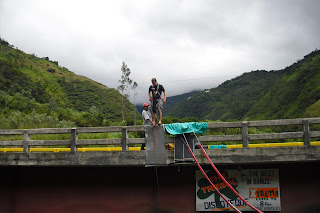It’s not just Spanish you need to have a decent grasp of to be in a position to truly get by in Colombia. OK, there are lots of things outside of the language that are necessary to understand before you can attempt to ‘get it’ here.
Some of those, such as relationships, we’ve discussed on many occasions and we’ll probably never figure out; but on a quirkier note we’re going to take a look at what you might call Colombia’s ‘speechless language’ (use of gestures, hand signals and facial expressions that all have special meanings) that we’ve seen used daily here.
This list isn’t exhaustive but it details the ones we like the best:
Tacaño(a) – Mr Scrooge
This signal is done by raising one of your elbows and slapping it with your other hand. It basically describes a person who is tight-fisted with money. Of course, our mantra has always been there is a big difference between being mean and wise with your cash – we like to think we fall into the latter category. Nonetheless, some Colombians don’t agree it would appear.
Paila – something’s wrong
The open hand or one finger cutting to the neck gesture signifies that something is wrong or not going to happen. Well, in fact, we’ve seen it used in many circumstances, but it’s always in a negative sense, such as some place is closed so you can’t go. If it’s used for your ‘delectation’, then you need to revise your plans.
Llena/tetiado – ‘No space in here tonight, buddy.’
For those who follow Italian hand signals, this means something completely different – that is something is really good we believe. Here in Colombia though it means a place is packed full of people.
Ladron/ratero – ‘Beware, there’s a thief about.’
Don’t misread/ignore this one, it could save you a peso or two. When you’re on the Transmilenio* and you see a guy staring at you lightly scratching his cheek, it isn’t just that he has an itch. It’s more than likely a warning that there’s a thief about, so hold on tightly to your stuff. This is not the time – as if there ever is one – to ‘dar papaya’ (see http://bit.ly/XLDyLg for more on that).
Lip-synced
Why point directions when you can use your lips? It works for many Colombians anyway. They’re not being rude, they’re telling you the way to go (we’ll let the fact slip that the directions they give tend to be wrong – it’s the thought that counts, right?).
‘My child is not a dog’
We never gave much thought about demonstrating the height of somebody until we got to Colombia. Etiquette exists though and if you get it wrong you might upset somebody. To show the height of a person, you put your hand out vertically; for an animal, horizontally. It’s best not to confuse the two. Regardless of the behaviour of someone’s child, you don’t want to give the impression that you think they’re not human – well then again...
Tonto/idiota/gueva/marica – ‘You amadán’ (Irish language one, that) or fool
Two can work for this. The first is a dumb facial expression with hands out like you’re holding a ball under your chin, slightly shaking them. The second is just one of your hands, palm side up, again waving it a little directly under your chin.
Que cagada – ‘What a b****cks!’
When you notice somebody not being very sincere with another person – being two-faced for one – you can express your displeasure (or approval as the case may be) by loosely shaking your floppily held hand at the side of your head.
Montada – scissor fingers
If somebody’s in your face a bit too much or giving you hassle, use your index and middle fingers as scissors ‘cutting’ the wrist of your other hand to let them know you want them to back off and cut you some slack. If that doesn’t work, make a fist shape out of your strongest hand and aim it with force at the person’s face.
‘Feckin’ hell’
A floppy shake of the hand in front of your body is used when something happens that surprises or shocks you. We’ve got to the stage in this country where we hardly ever feel the need to use this – unless of course somebody turned up on time for an event. So no, we haven’t used it.
Marica – queer/gay
Covering your nose with your hand and gently rubbing it with your thumb and index finger signifies that you think somebody is gay or ‘marica’ as they say in Colombia. Do note that the word marica is used in an affectionate way too; you’ll hear people addressing good friends with it. It’s also used in contexts that may surprise you or for something daft as listed above.
 |
| Tight-arse. |
This signal is done by raising one of your elbows and slapping it with your other hand. It basically describes a person who is tight-fisted with money. Of course, our mantra has always been there is a big difference between being mean and wise with your cash – we like to think we fall into the latter category. Nonetheless, some Colombians don’t agree it would appear.
 |
| Not good. |
Paila – something’s wrong
The open hand or one finger cutting to the neck gesture signifies that something is wrong or not going to happen. Well, in fact, we’ve seen it used in many circumstances, but it’s always in a negative sense, such as some place is closed so you can’t go. If it’s used for your ‘delectation’, then you need to revise your plans.
 |
| Italianate but Colombian. |
Llena/tetiado – ‘No space in here tonight, buddy.’
For those who follow Italian hand signals, this means something completely different – that is something is really good we believe. Here in Colombia though it means a place is packed full of people.
 |
| Watch your stuff. |
Ladron/ratero – ‘Beware, there’s a thief about.’
Don’t misread/ignore this one, it could save you a peso or two. When you’re on the Transmilenio* and you see a guy staring at you lightly scratching his cheek, it isn’t just that he has an itch. It’s more than likely a warning that there’s a thief about, so hold on tightly to your stuff. This is not the time – as if there ever is one – to ‘dar papaya’ (see http://bit.ly/XLDyLg for more on that).
 |
| Over there. |
Lip-synced
Why point directions when you can use your lips? It works for many Colombians anyway. They’re not being rude, they’re telling you the way to go (we’ll let the fact slip that the directions they give tend to be wrong – it’s the thought that counts, right?).
 |
| 'He was this high.' |
‘My child is not a dog’
We never gave much thought about demonstrating the height of somebody until we got to Colombia. Etiquette exists though and if you get it wrong you might upset somebody. To show the height of a person, you put your hand out vertically; for an animal, horizontally. It’s best not to confuse the two. Regardless of the behaviour of someone’s child, you don’t want to give the impression that you think they’re not human – well then again...
 |
| You're stupid, boy. |
Tonto/idiota/gueva/marica – ‘You amadán’ (Irish language one, that) or fool
Two can work for this. The first is a dumb facial expression with hands out like you’re holding a ball under your chin, slightly shaking them. The second is just one of your hands, palm side up, again waving it a little directly under your chin.
 |
| Uhh-eeee. |
Que cagada – ‘What a b****cks!’
When you notice somebody not being very sincere with another person – being two-faced for one – you can express your displeasure (or approval as the case may be) by loosely shaking your floppily held hand at the side of your head.
 |
| 'Back-off lad.' |
Montada – scissor fingers
If somebody’s in your face a bit too much or giving you hassle, use your index and middle fingers as scissors ‘cutting’ the wrist of your other hand to let them know you want them to back off and cut you some slack. If that doesn’t work, make a fist shape out of your strongest hand and aim it with force at the person’s face.
 |
| Ushhhh!!! |
‘Feckin’ hell’
A floppy shake of the hand in front of your body is used when something happens that surprises or shocks you. We’ve got to the stage in this country where we hardly ever feel the need to use this – unless of course somebody turned up on time for an event. So no, we haven’t used it.
 |
| 'He's a bit camp.' |
Marica – queer/gay
Covering your nose with your hand and gently rubbing it with your thumb and index finger signifies that you think somebody is gay or ‘marica’ as they say in Colombia. Do note that the word marica is used in an affectionate way too; you’ll hear people addressing good friends with it. It’s also used in contexts that may surprise you or for something daft as listed above.
Basically it’s used for practically all situations from what we can gather (sure we’re all gay at heart) – so if you really want to point out somebody is gay, use the gesture.
________________________
*If you need reminding what the Transmilenio is, see: http://bit.ly/N68gKL
A big thanks to Pedro for demonstrating these gestures - Colombia's next top model perhaps?
________________________
*If you need reminding what the Transmilenio is, see: http://bit.ly/N68gKL
A big thanks to Pedro for demonstrating these gestures - Colombia's next top model perhaps?







